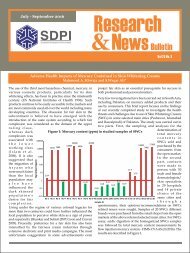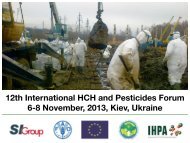Women and Chemicals
WomenAndChemicals_PublicationIWD2016
WomenAndChemicals_PublicationIWD2016
Create successful ePaper yourself
Turn your PDF publications into a flip-book with our unique Google optimized e-Paper software.
Where are women exposed to chemicals?<br />
bronchitis, heart diseases <strong>and</strong> emphysema in adult women.<br />
Use of biomass fuel (woodfuel <strong>and</strong> charcoal) may also lead to<br />
diseases like cataracts <strong>and</strong> low birth weight in babies of exposed<br />
expectant mothers. As poor women <strong>and</strong> children are<br />
the main victims of this kind of indoor pollution, a compelling<br />
alternative needs yet to be established.<br />
Another common source for diseases in homes is mould.<br />
It grows naturally in humid areas of the house. Often colonies<br />
can be found underneath the wallpaper or behind cupboards.<br />
Mould fungi, even when dead, can trigger asthma, irritation of<br />
the skin <strong>and</strong> mucous membranes or flu-like symptoms. Recent<br />
studies show that exposure to mould affects women in a<br />
different way than men. One study has shown that dampness<br />
<strong>and</strong> indoor mould growth common in dwellings is a risk factor<br />
for lung function decline, especially in women. 16 Badly<br />
functioning ventilation systems or highly insulated houses,<br />
where air cannot circulate properly, are high risk factors for<br />
developing mould.<br />
Other sources for indoor air pollution are harmful chemicals<br />
off-gassing from products like furniture, clothes, carpets,<br />
toys, etc. To reduce exposure, rooms need to be aired frequently<br />
<strong>and</strong> products containing harmful chemicals have to be<br />
avoided. Since strict laws banning hazardous chemicals in<br />
products are rarely in place <strong>and</strong> often good information on<br />
chemical content is not available, this is very difficult to implement<br />
for the individual consumer.<br />
Typical exposure source at home –<br />
cleaning detergents<br />
Cleaning the house is still mainly the task of women<br />
around the world. “The more, the better” is common thinking<br />
in terms of cleaning detergents, which leads to overdosing,<br />
although modern cleaners work effectively even in small doses.<br />
Many chemicals contained in household cleaning <strong>and</strong> care<br />
products are the same as those used in industrial cleaning<br />
agents. They can contain strong irritants, sensitizing <strong>and</strong> allergenic<br />
substances <strong>and</strong> fragrances, phosphates, carcinogenic<br />
<strong>and</strong> neurotoxic solvents. Some of the most observed effects<br />
are skin irritations, allergies <strong>and</strong> respiratory problems. The effect<br />
of household cleaning agents on women is not well<br />
known. However, there are occupational health studies showing<br />
effects on women. The ILO states “Some large populationbased<br />
epidemiological studies have found high cancer rates<br />
among cleaners“. 17 Among women, invasive cervical cancer is<br />
almost five times more common among cleaners than other<br />
women. These results are attributed to chemical exposures,<br />
particularly solvents.“ 18<br />
31







